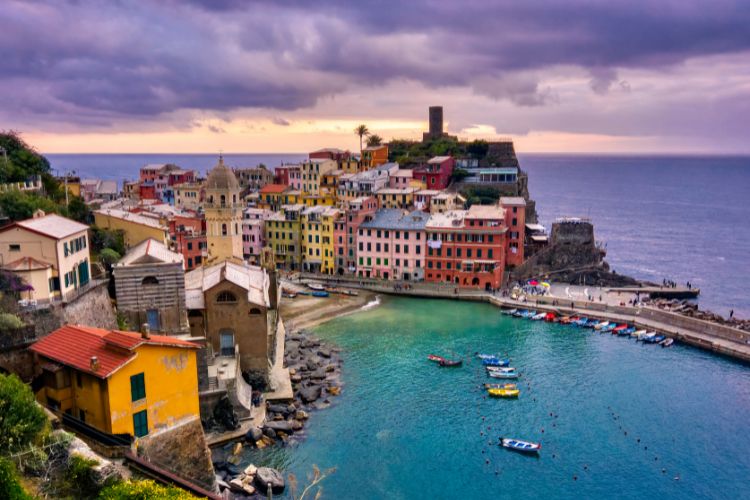In the U.S., the Mediterranean diet is typically characterized by abundant plant foods (fruit, vegetables, breads, other forms of cereals, beans, nuts and seeds), fresh fruit as the typical daily dessert, olive oil as the principal source of fat although canola oil has been substituted in some Mediterranean cookbooks sold in the U.S. Note that canola is not Mediterranean and is a highly processed oil, that I recommend avoiding. Small amounts of dairy products (principally cheese and low-fat yogurt) and small amounts of poultry. Fish, with an emphasis on salmon is considered to be the primary protein source and low to moderate amounts of eggs and red meat may be consumed but sparingly, zero to four eggs consumed weekly, red meat consumed in low amounts or not at all.
Contrary to media portrayals of the Mediterranean diet, salmon is not the most common fish found on Mediterranean menus. There is salmon in the Mediterranean Sea, however, it’s not native to the region. It is typically farmed rather than wild caught. It can be found in grocery stores and on the menus of some restaurants however there are many other varieties of fish and seafood that are native, incredibly delicious, and what traditional Mediterranean people would choose to eat. That’s not to say that salmon is not healthy. Wild caught salmon is a nutrient dense food and very healthy for us containing an abundance of omega 3 fats. But, it’s not a traditional Mediterranean food.
A traditional Mediterranean diet consists of fresh local food that has been grown or caught in that region. For coastal towns, the diet tends to include an abundance of fresh fish. For inland regions, beef or lamb, might be the primary protein source. A large variety of vegetables is enjoyed and deliciously prepared with seasonings and butter or olive oil. Dairy is consumed in its most natural form including aged cheeses, unsweetened whole milk yogurt and cream. Pasta is served in moderation. The pasta course in Italy is typically a small serving consisting of couple of raviolis or a small portion of gnocchi with sauce. The main course would consist of a protein and vegetables. Small quantities of legumes are consumed and are properly prepared by soaking and slow cooking.
In my circle of Mediterranean family and friends, I have never met a single vegetarian. This is not to say that none of my Mediterranean family and friends have chosen a vegetarian diet, but when they do so, it reflects a personal preference and is not the Mediterranean diet. The Mediterranean is a vast area that consists of many countries and regions. The foods consumed vary from region to region depending on what’s available. But, the health and longevity of the Mediterranean people as whole is rooted in the nutrient dense food that is local and as close to its original source as created in nature.
For anyone wanting to try a traditional Mediterranean diet, here are a few regional favorites to consider.
Mediterranean Specialties
Valencia Spain
While I am not Spanish, I am fortunate to have married into family who has Spaniard ties and they just happen to enjoy cooking paella (pronounced pai-ay-uh). Paella gets its name from the paellera, a large flat round pan with handles. Paella is traditionally cooked over a wood burning fire and eaten right from the pan. Paella is made with arborio rice, plenty of peppers, onions and garlic, tomatoes, garbanzo beans, chicken, seafood and Spanish chorizo or linguisa. Its primary spice is saffron. Taking note from our Spanish relatives, Steve and I built an outdoor fire-pit that perfectly fits a large paellera pan 36” wide! We cook it over an open fire, turning the mixture with a spatula that looks like a boat paddle, and then enjoy it with about 50 or 60 of our closest friends and family. Yes, our recipe feeds masses of people but that’s what makes it so fun!
Mallorca Spain
In Mallorca, one of the most famous Spanish culinary delights is cured ham, with the two main varieties being Jamón Ibérico and Jamón Serrano. They can be compared to Italy’s prosciutto, Mallorca’s particularly famous and mouth-watering version is produced from a “black” pig that feeds solely on acorns. When we have access to it, Jamón Serrano thinly sliced right off the bone is a delicious accompaniment to our paella parties.
Florence Italy
Florence s in the heart of Italy’s cattle country and is famous for rich, flavorful local beef from the Chianina cow. Italy does not need to use categories of grass-fed or grain-fed cows because after all cows eat grass and that’s what Italians feed them. Florence is known for Bistecca alla Fiorentina, aka Steak Florentine. Steak Florentine is a thick cut T-bone grilled on a wood or coal fire with simple seasonings of salt and pepper and sometimes finished with chopped rosemary and olive oil, although Italians say a good steak should be moist and delicious enough without the olive oil and it shouldn’t need “extra juices”. When our family visited Florence, a petite local woman told us that as a Florentine she enjoys Bistecca alla Fiorentina on a weekly basis and often saved her appetite all day to indulge in a large juicy steak. We enjoyed it so much that I included a recipe for Steak Florentine in my cookbook.
Cinque Terre Italy
Cinque Terre is string of 5 villages on the rugged coast of the Italian Riviera coastline. The harbors are filled with fishing boats and trattorias that serve a variety of seafood specialties. Access to Cinque Terre is primarily by train and limited by car to a few narrow and mountainous roads some of which end before reaching the town. The residents of Cinque Terre, like the residents of most Italian villages and provinces, take much care and pride in preparing local and fresh food. Restaurants in Cinque Terra boast a large variety of sea food dishes both with and without pasta.
Greece
While I have not had the opportunity as of yet to visit, nor do I have family ties to Greece, Greek food is at the top of my favorites! From lamb kabobs to tzatziki and gyro’s to avgolemono, a Greek lemon chicken soup, Greek food is bursting with a variety of flavors and of course is always local so recipes depend heavily on the ingredients that are grown or caught nearby.
As you can see, the variety of Mediterranean foods depends very much on the region and what foods are available. The one thing they have in common is fresh, local food – real food much like the recipes you can find in The Simply28 Real Food Cookbook.
Buon appetite, Italy
Kali oreksi, Greece
Buen provecho, Spain
Enjoy your meal, United States




